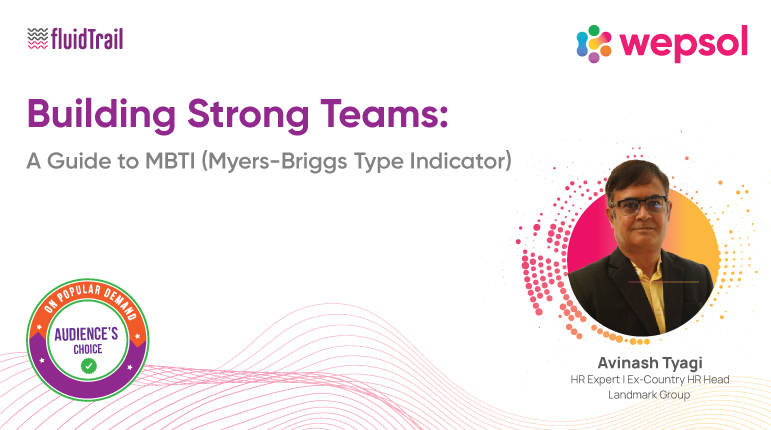Brought to you by fluidTrail by Wepsol – A document management and workflow automation solution for all organizations.
Avinash Tyagi brings over 25 years of experience in strategic HR, business restructuring, performance management, global recruitment, and tech implementation. Avinash has held senior HR positions in various industries.
In our webinar, we cover:
- An overview of the Myers-Briggs Type Indicator.
- Enhancing team dynamics with MBTI for awareness
- Effective communication strategies based on personality types.
- Assigning roles within the team using MBTI insights.
- Techniques for resolving conflicts within teams.
- Much more.
Listen now on Youtube.
“Try your Traits before trying _________”
Audience: luck!, judgement!, faith!, fate!….,
Avinash: It’s “Try your Traits before trying our fate.” First, we have to understand ourselves and how we differ from other people. If we are not aware of our traits, it’s very difficult to understand others.
Imagine you’re hiring someone to take care of your garden. You meet a farmer who seems perfect, understanding the fundamentals of plant care. Convinced of his expertise, you hire him. But soon, you notice something troubling – while your garden has a variety of flowers, they aren’t thriving as expected, unlike your neighbour’s well-nurtured garden.
Upon closer observation, you realise the farmer excels at growing just one crop. Each type of flower requires different care – specific fertilisers, watering schedules, and soil conditions. The farmer’s methods, effective for a single crop, don’t work for a diverse range of plants.
Now, let’s bring this analogy into the workplace. As a leader, you may be using a one-size-fits-all management style for all your employees. Sure, the organisation may be growing, but is it thriving? When you ask employees how they’re doing, some may respond sarcastically with “surviving,” while others are genuinely engaged and flourishing.
The difference between surviving and thriving lies in how well you understand the unique personality types within your team.
Why Employee Personalities Matter in Business Success
Every employee has their own set of strengths, preferences, and behaviours. Treating everyone the same way may be difficult for some employees’ potential, just like trying to grow different flowers with a single-method approach. The key to building a successful workforce is recognizing and understanding their differences.
One popular tool for this purpose is the Myers-Briggs Type Indicator (MBTI). This self-reporting tool helps any individuals identify their personality types, preferences, and strengths. As a manager/ leader , by understanding the personality types within your team, you can design your management strategies to help everyone success, creating a healthy, more engaged work environment.
What is the Myers-Briggs Type Indicator (MBTI)?
The MBTI, developed by Isabel Myers and her mother, Katherine Briggs, is based on Carl Jung’s theory of personality types. It has been used for more than 60 years in research, team development, and individual growth. The MBTI focuses on four main areas:
- Extraversion (E) vs. Introversion (I) – How individuals get their energy.
- Sensing (S) vs. Intuition (N) – How people perceive information.
- Thinking (T) vs. Feeling (F) – How decisions are made.
- Judging (J) vs. Perceiving (P) – How individuals interact with the outside world.
Type of dichotomies (pair of preferences):
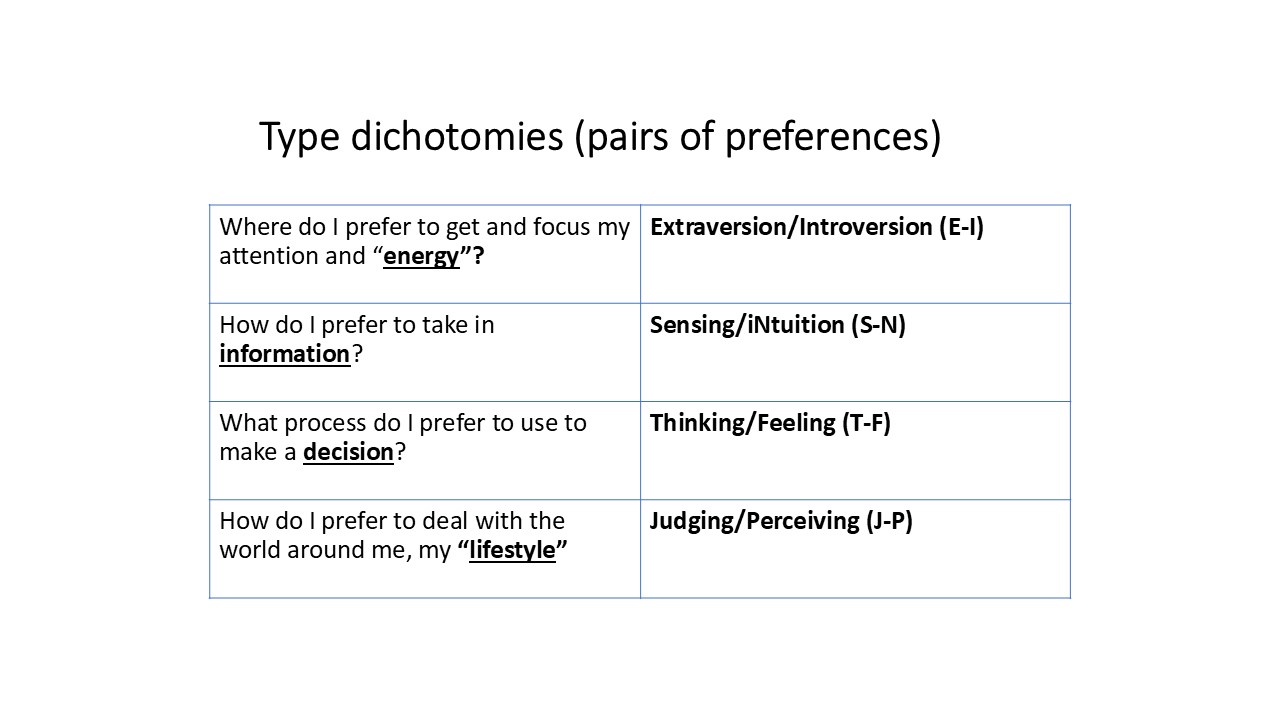
What is dichotomies:
- Are innate, are not same as skills , abilities, or traits, which have a magnitude that can be measured
- Based on these dichotomies, you are interacting with or around the world.
- Preferences do not change – they stay the same over our lifetime.
- No preferences are good/bad, better/worse ( you can’t say rose is better than lotus or apple better than orange, it’s all individual choice)
Let’s explore deep into each of the dichotomies:
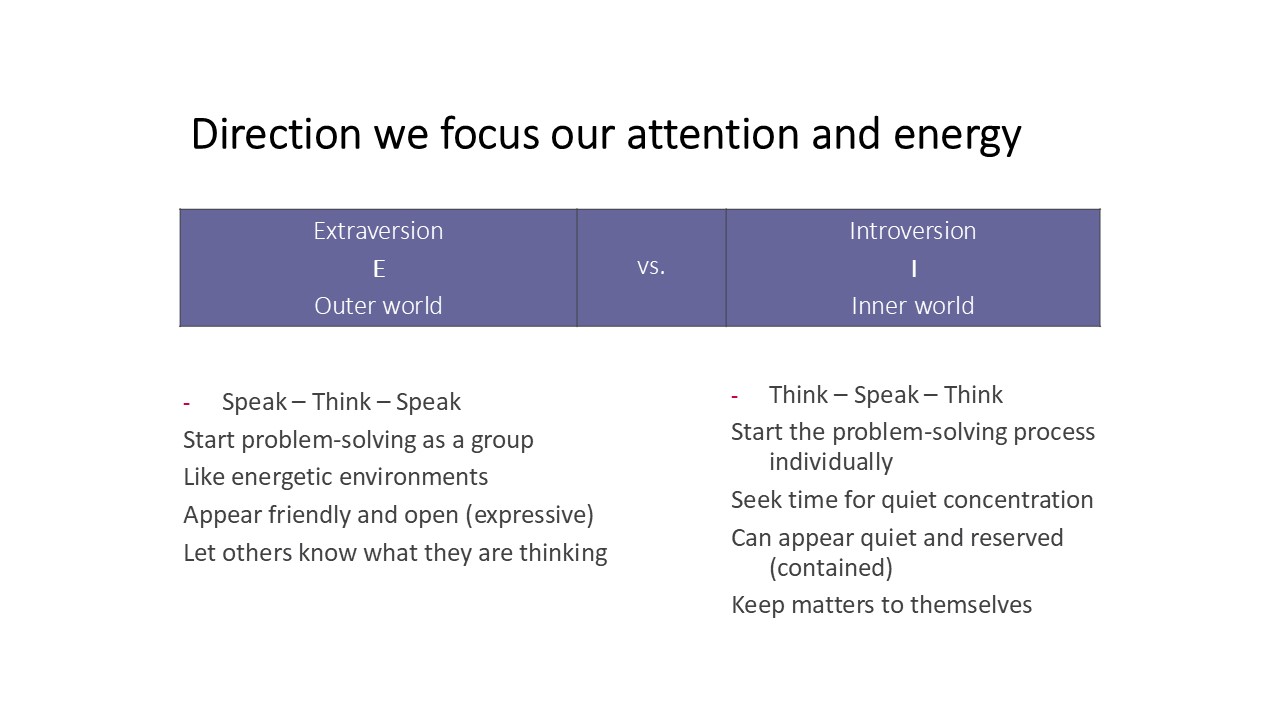
Extraversion:
Extraversion is a key trait of individuals who enjoy engaging with the outside world. They tend to speak first to clarify their thoughts and then think, often solving problems in group settings. They thrive in lively environments and usually come across as friendly and open. Extraverts like to share their ideas openly, making them appear expressive and approachable.
Introversion:
Introversion is a trait that describes internal reflection. Introverts typically follow a “think-speak-think” pattern, carefully thinking things through before speaking and then reflecting on the feedback afterward. They usually like to figure things out on their own and need some quiet time to think. This can make them seem quiet and reserved because they keep their thoughts and feelings to themselves.
Let’s take some time here and observe commonly preferred extraversion & preferred introversion behaviour. Remember, it’s not about one type being better or another being bad; its all about you understanding what you prefer / what your personality reflects among these behaviours.
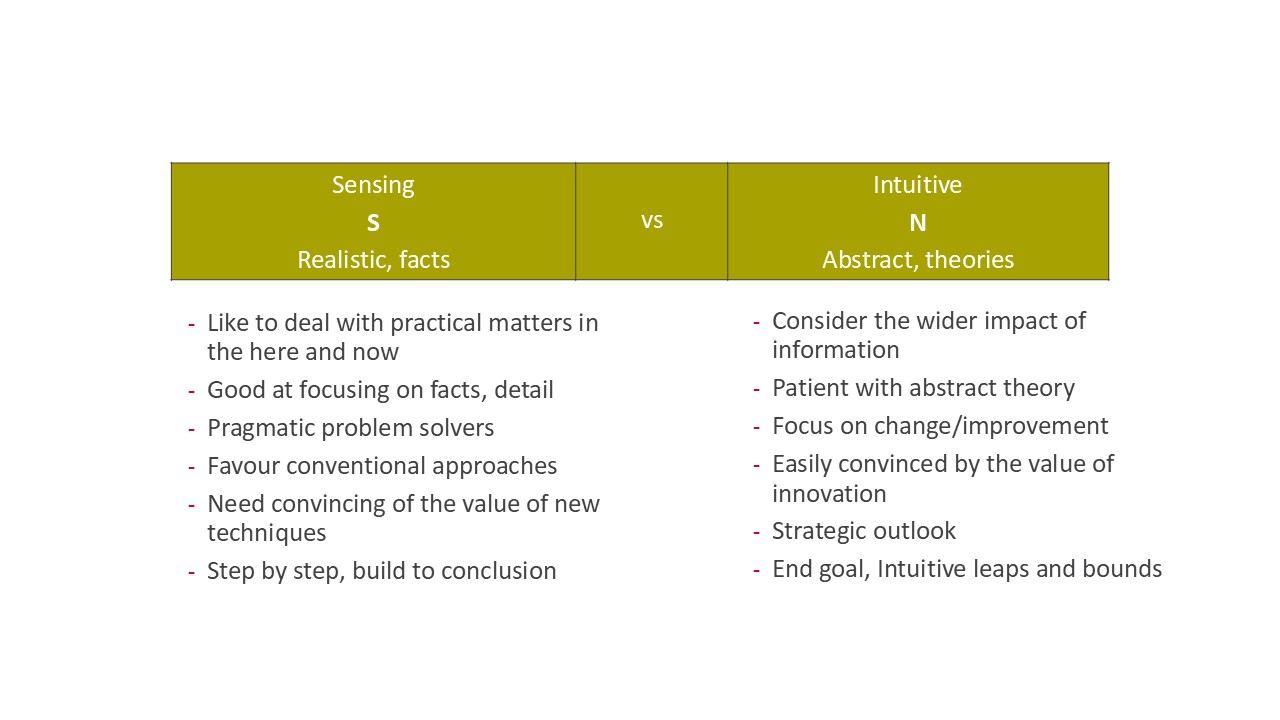
Sensing:
People with sensing behaviour are practical and focused on the present. They are good at noticing facts and details and solving problems in a realistic, step-by-step way. They tend to stick with tried-and-true methods and often need convincing to try new techniques
Intuitive:
People with intuitive behaviour focus on abstract ideas and theories. They think about the wider impact of information and are patient with complex concepts. They aim for change and improvement, easily seeing the value in innovation. With a strategic outlook, they often make intuitive leaps towards their end goals.
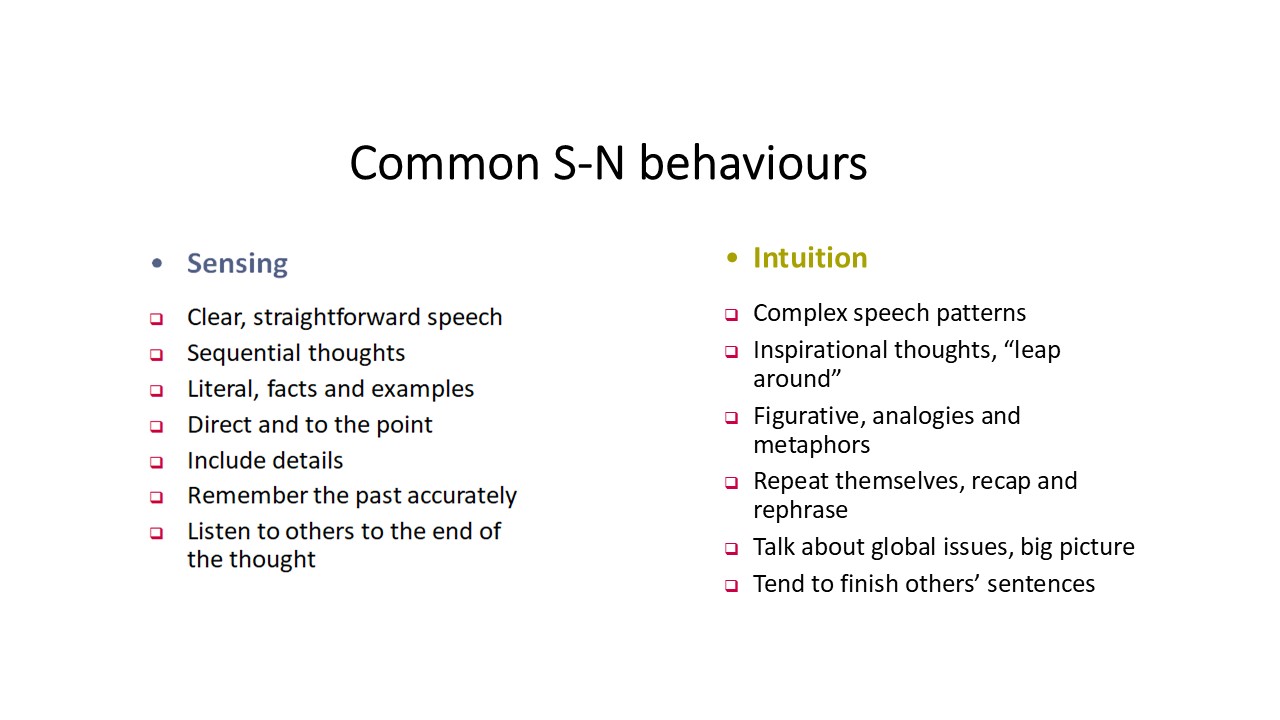
Lets take some time here, these are common behaviours which people are sensing or people with intuition will usually have. It is very confusing for the people with S type to understand people with I type. Because they always asks for clear & particular details but I type people maintains information very generalised and jump to conclusion.
“MBTI is not measure for IQ”
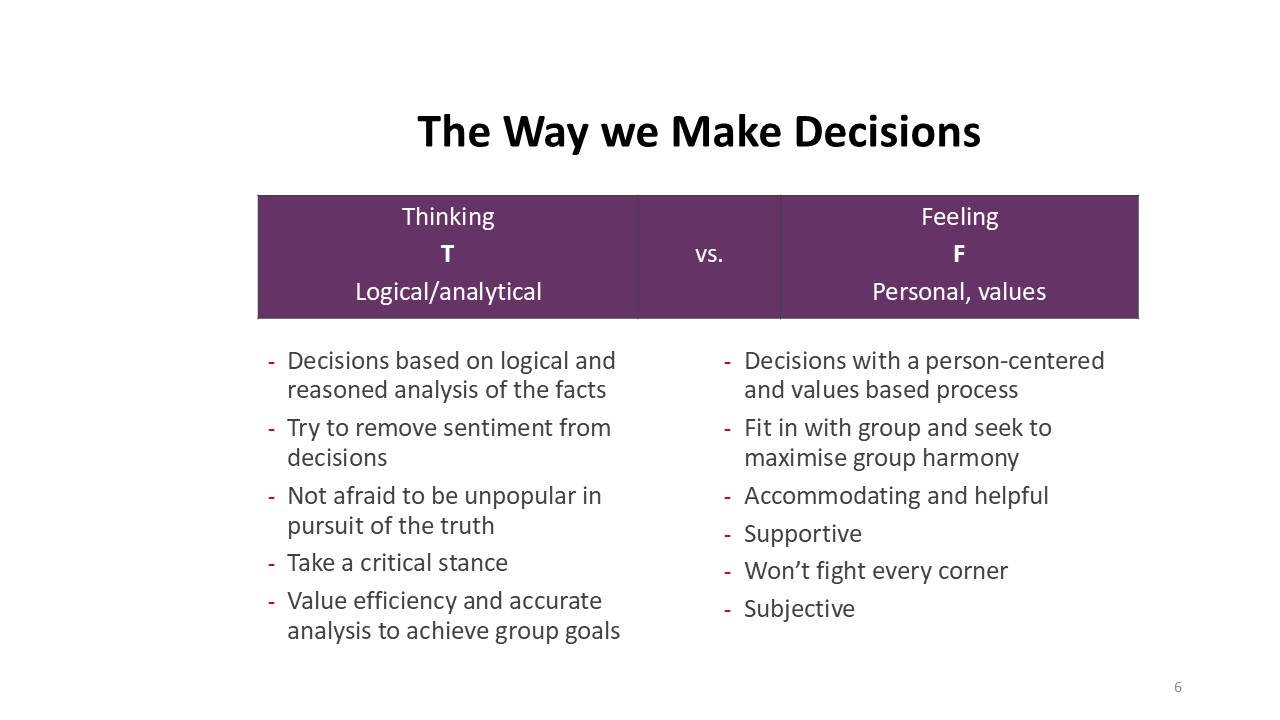
Thinking:
People with a thinking behaviour make decisions based on logic and facts. They try to keep emotions out of their decisions and are not afraid to be unpopular if it pursues the truth. They take a critical approach, value efficiency, and accurate analysis to achieve group goals.
Feeling:
People with a feeling behaviour make decisions based on personal values and a focus on others. They aim to fit in with the group and maximize harmony, being accommodating and helpful. They tend not to argue every point, and their approach is more subjective.
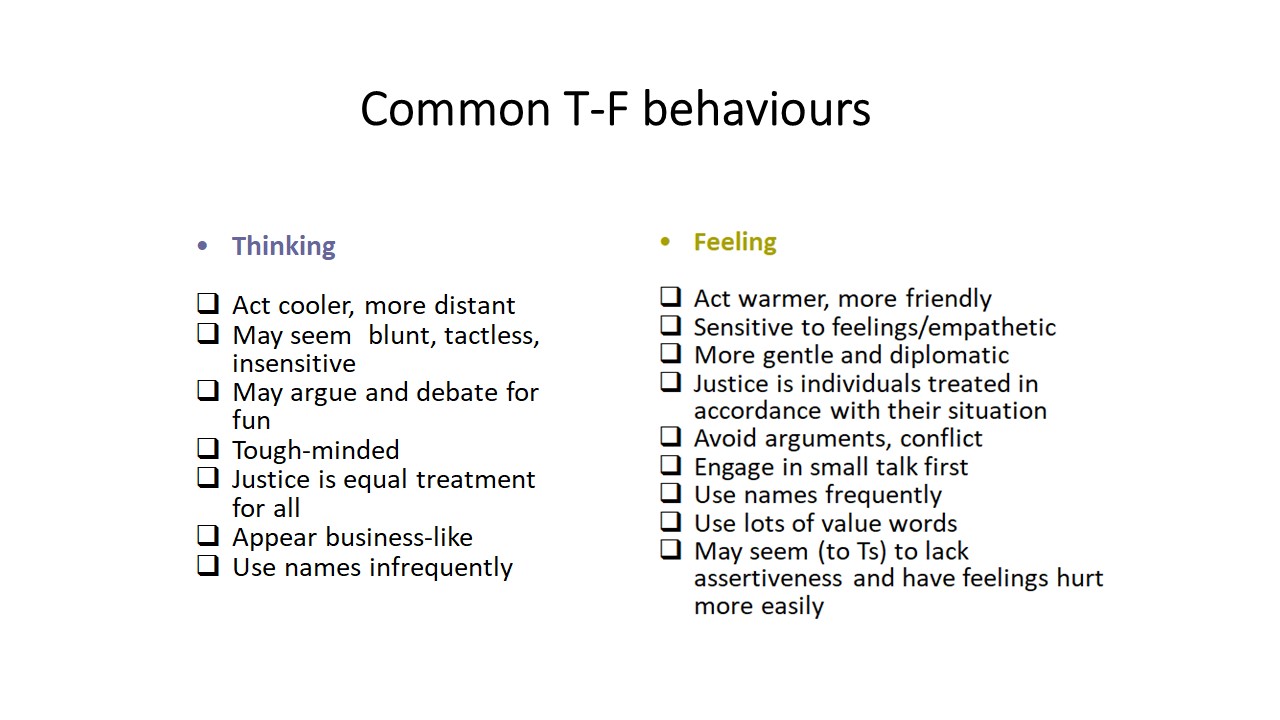
So, these are the common behaviours of people who are into thinking and who are into feeling. People with thinking act very cooler and look for facts, but for people with feeling, they may seem blunt and tactless.
Example: We had a store manager from a large retail chain, and we gave the entire team one simple instruction: control costs. Sounds straightforward, right? But here’s where it gets interesting.
Take the pantry guy, for example. He took this instruction to heart. Not only did he track the number of teacups used, but he also counted the used ones in the trash! His goal? To monitor tea consumption down to the last sip. This shows the kind of practical, no-nonsense thinking that focuses on results, not emotions / not doing favours.
It’s all about sticking to the objective & staying laser-focused on the outcome.
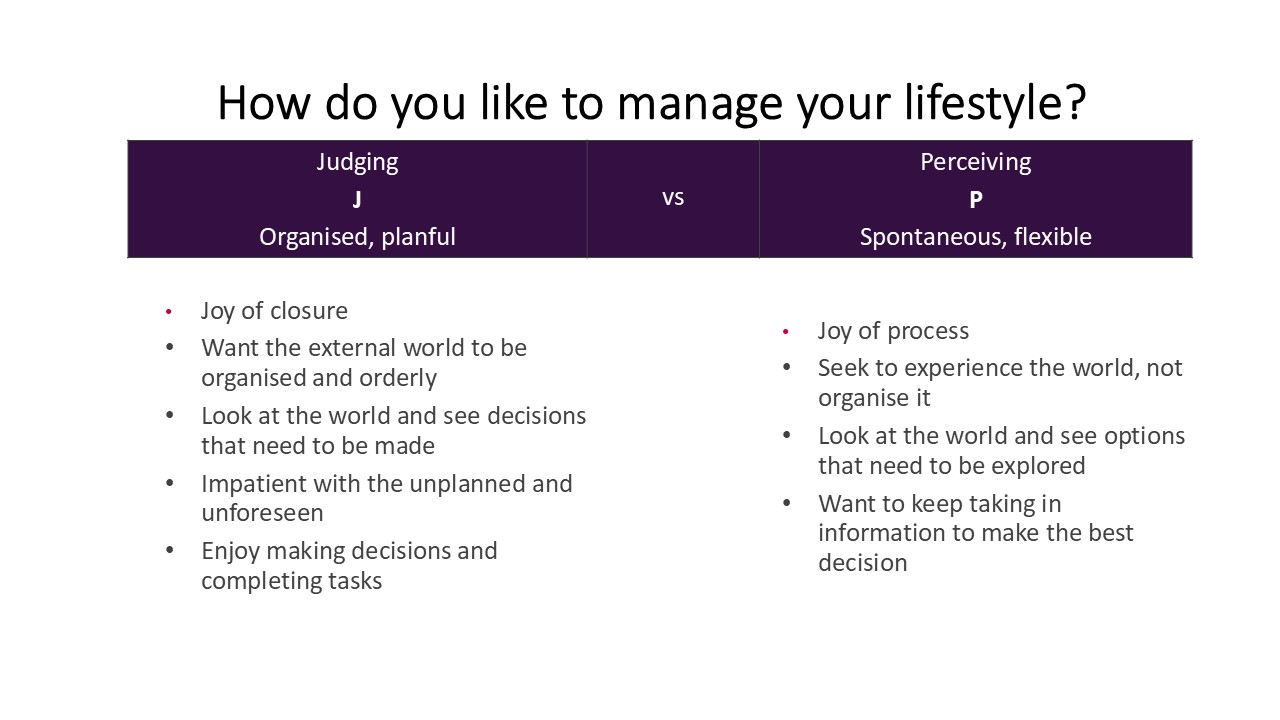
Judging:
People with judging behaviour like things to be organized and orderly. They enjoy making decisions and completing tasks, and they often see what needs to be done right away. They can get impatient with unexpected changes or unplanned events. Overall, they thrive in structured environments where they can bring things to a close.
Perceiving:
People with a perceiving behaviour enjoy the process of exploring & experiencing the world than organizing it. They see various options to be explored and prefer to keep gathering information before making decisions. They are flexible, can easily adapt to new situations/changes.
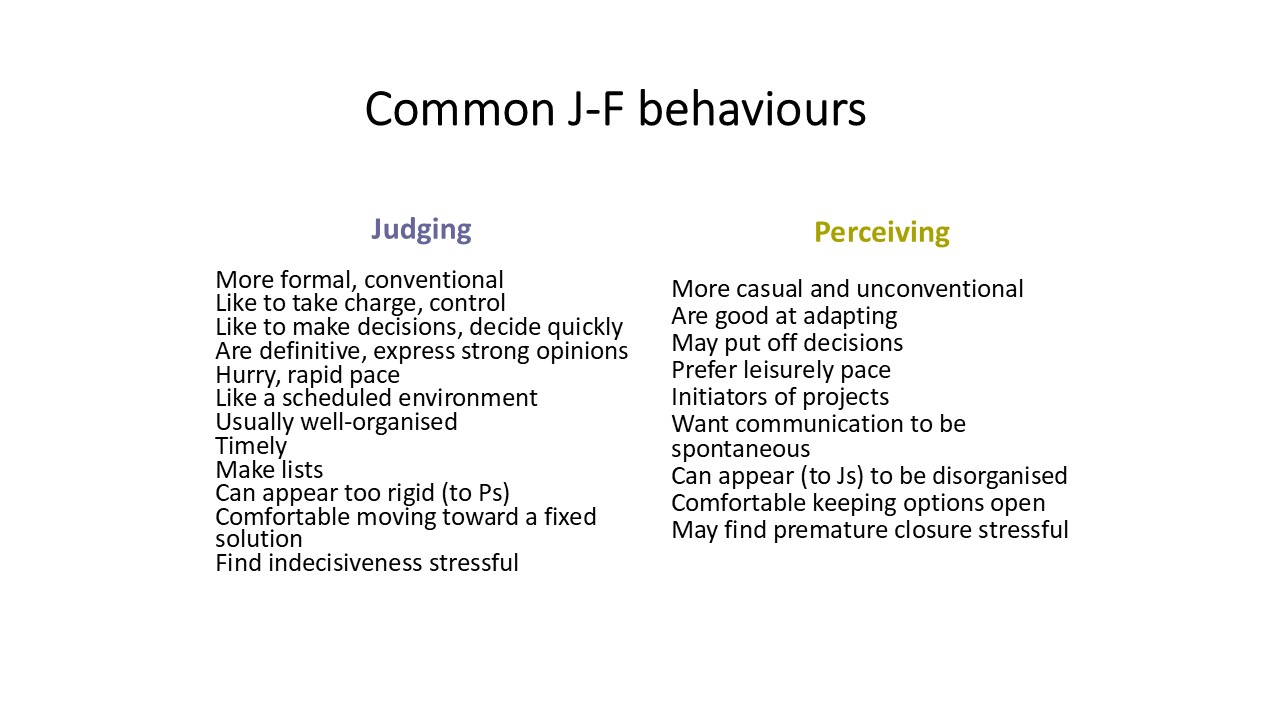
Things to Remember:
1. True Type May Be Hidden by External Factors
Your true personality preferences might not be apparent due to influences like socialisation, role, company culture, or personal style.
2. There’s No Right or Wrong Type
No MBTI type is inherently better or worse; each type has its own strengths and value.
3. No Perfect Type Combinations
There is no ideal combination of personality types for success in work or relationships; every type brings unique qualities.
4. Everyone Is Unique
Even within the same type, each person is distinct due to personal experiences and individual differences.
5. We All Use All Preferences to Some Degree
While we may have dominant preferences, everyone uses aspects of all types in different situations.
6. Type Doesn’t Explain Everything
MBTI provides useful insights but doesn’t capture the full complexity of personality and behaviour.
How to conduct Group exercises for Team Building:
- Pre-Assessment: by team members to identify their personality types.
- Workshops: Conduct interactive workshops where team members learn about MBTI and how it applies to their roles.
- Activities: Implement activities that leverage the insights gained from MBTI assessments. Use tools like Kahoot! for quizzes and Miro for collaborative exercises.
- Follow-up: Gather feedback using SurveyMonkey or similar tools to assess the exercise’s impact and identify areas for improvement.
- Continuous Learning: Encourage ongoing learning and development with resources like Type Coach and StrengthsFinder to help team members continually improve their interpersonal skills.
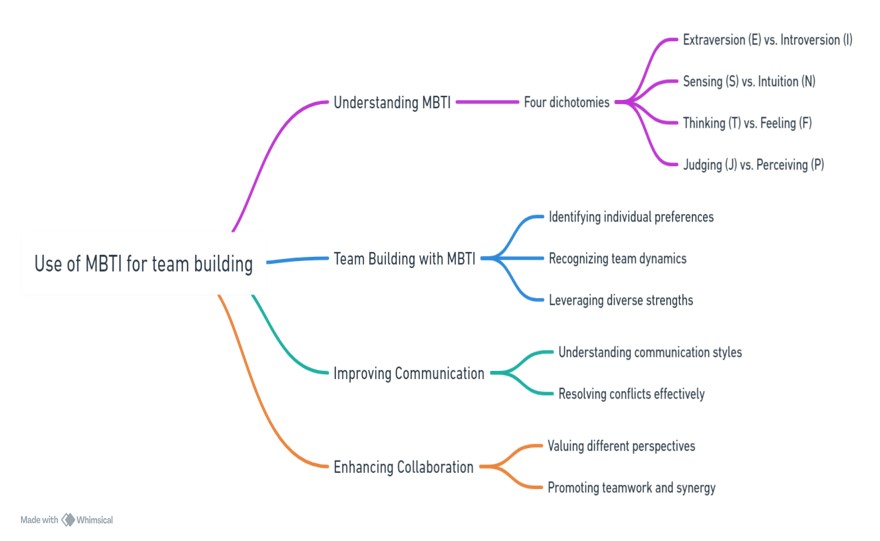
Impact of Types in Team Settings:
- Similar types are quicker to understand each other; Different types are slower
- Groups with high similarity reach quicker decisions but are more error-prone because of fewer views
- Team members who are opposite on all four preferences have special problems in achieving understanding
- Teams that appreciate different types and use accommodating behaviours experience less conflict
- Leaders and teams that appreciate type diversity will likely overcome conflict more successfully.
Bonus: Checkout free tools to check your personality Here
In world of business, building & managing a strong team is essential for growth. When we understand and use each team member’s unique personality and strengths, it increases productivity, teamwork, and success. At FluidTrail, we know how challenging it can be to manage & organize manual processes. Our platform makes it easier for teams by automated process workflows.

